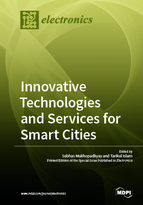Innovative Technologies and Services for Smart Cities
A special issue of Electronics (ISSN 2079-9292). This special issue belongs to the section "Networks".
Deadline for manuscript submissions: closed (31 October 2018) | Viewed by 73717
Special Issue Editors
Interests: smart sensors; sensing technology; WSN; IoT; ICT; smart grid; energy harvesting
Special Issues, Collections and Topics in MDPI journals
Interests: capacitive sensors; impedance sensors; surface acoustic wave sensors; fractional order constant phase sensors; sensors array for e-nose; interfacing circuits for the sensors; signal conditioning circuits (analog/digital); measurements of physical and chemical parameters; health monitoring for smart grids (Gas Insulated Switch Gear and Protection Transformer); automatic dispensing system; structural health monitoring; food quality; smart agriculture
Special Issues, Collections and Topics in MDPI journals
Special Issue Information
Dear Colleagues,
Less budget, resource constraints, and continuous software upgrades are a few problems affecting the implementation of smart cities. The only solution to these problems is to develop smarter technology and a more efficient usage in order to meet the needs of smart cities. A combination of smart sensors, universal platform, Information and Communication Technologies (ICT), Internet of Things (IoT), energy harvesting, cloud computing, and open source technologies, compatible with Next Generation Networks (NGN), will help towards the actual achievement of a smart city. It is now possible to develop significant technology platforms and IoT solutions for smart cities without a massive investment. However, IoT interoperability is still at a very early stage and standardization is difficult to achieve as it is usually led by companies with strong market positions. There is a need for stand-alone development, where large companies will not dictate terms and conditions.
The aim of this Special Issue is to report on the design and development of smart sensors, a universal interfacing platform, along with the IoT framework, extending it to next generation networks (4G, 5G, and future networks) for monitoring parameters of interest with the goal of achieving smart cities. Examples of this work include developing novel sensors for monitoring environmental pollution and other parameters, and making the data available to a wider community through remote access cloud computing. The proposed universal interfacing platform with the IoT frame work will solve many challenging issues and it will significantly boost the growth of IoT-related applications, not just in the environmental monitoring domain, but in the other key areas, such as smart home, wearables, smart city with smart waste management, smart E-metering, smart water supply, intelligent traffic control, smart grid, remote health care applications, etc., in any country. The need is to develop a low-cost solution so that any country, without investing a massive amount of resources, can exploit the research outcomes.
Dr. Subhas Chandra Mukhopadhyay
Dr. Tarikul Islam
Guest Editors
Manuscript Submission Information
Manuscripts should be submitted online at www.mdpi.com by registering and logging in to this website. Once you are registered, click here to go to the submission form. Manuscripts can be submitted until the deadline. All submissions that pass pre-check are peer-reviewed. Accepted papers will be published continuously in the journal (as soon as accepted) and will be listed together on the special issue website. Research articles, review articles as well as short communications are invited. For planned papers, a title and short abstract (about 100 words) can be sent to the Editorial Office for announcement on this website.
Submitted manuscripts should not have been published previously, nor be under consideration for publication elsewhere (except conference proceedings papers). All manuscripts are thoroughly refereed through a single-blind peer-review process. A guide for authors and other relevant information for submission of manuscripts is available on the Instructions for Authors page. Electronics is an international peer-reviewed open access semimonthly journal published by MDPI.
Please visit the Instructions for Authors page before submitting a manuscript. The Article Processing Charge (APC) for publication in this open access journal is 2400 CHF (Swiss Francs). Submitted papers should be well formatted and use good English. Authors may use MDPI's English editing service prior to publication or during author revisions.
Keywords
- Smart sensors
- sensing technology
- wireless sensor networks
- Internet of Things
- Smart Home
- Assisted Living
- Smart Cities
- Environmental Monitoring
- wireless protocol
- IoT framework
- Cloud computing







